Janus Cafe: UML Diagrams for Table Reserving, Ordering & Delivery
VerifiedAdded on 2023/06/03
|10
|988
|209
Project
AI Summary
This project outlines the UML diagrams for the Janus Cafe table reserving and food ordering system, covering business requirements for booking tables, online food ordering, food delivery, and customer feedback. Activity diagrams detail processes such as table booking, online food ordering, and order placement, including delivery options and feedback mechanisms. The use case diagram identifies actors like customers, drivers, and chefs, and their interactions with the system, such as registering, booking tables, ordering food, and updating delivery status. A sequence diagram illustrates the interaction between the customer and the system, including login, table booking, food ordering, payment, and feedback submission. The project aims to provide a comprehensive visual representation of the system's functionality and user interactions.
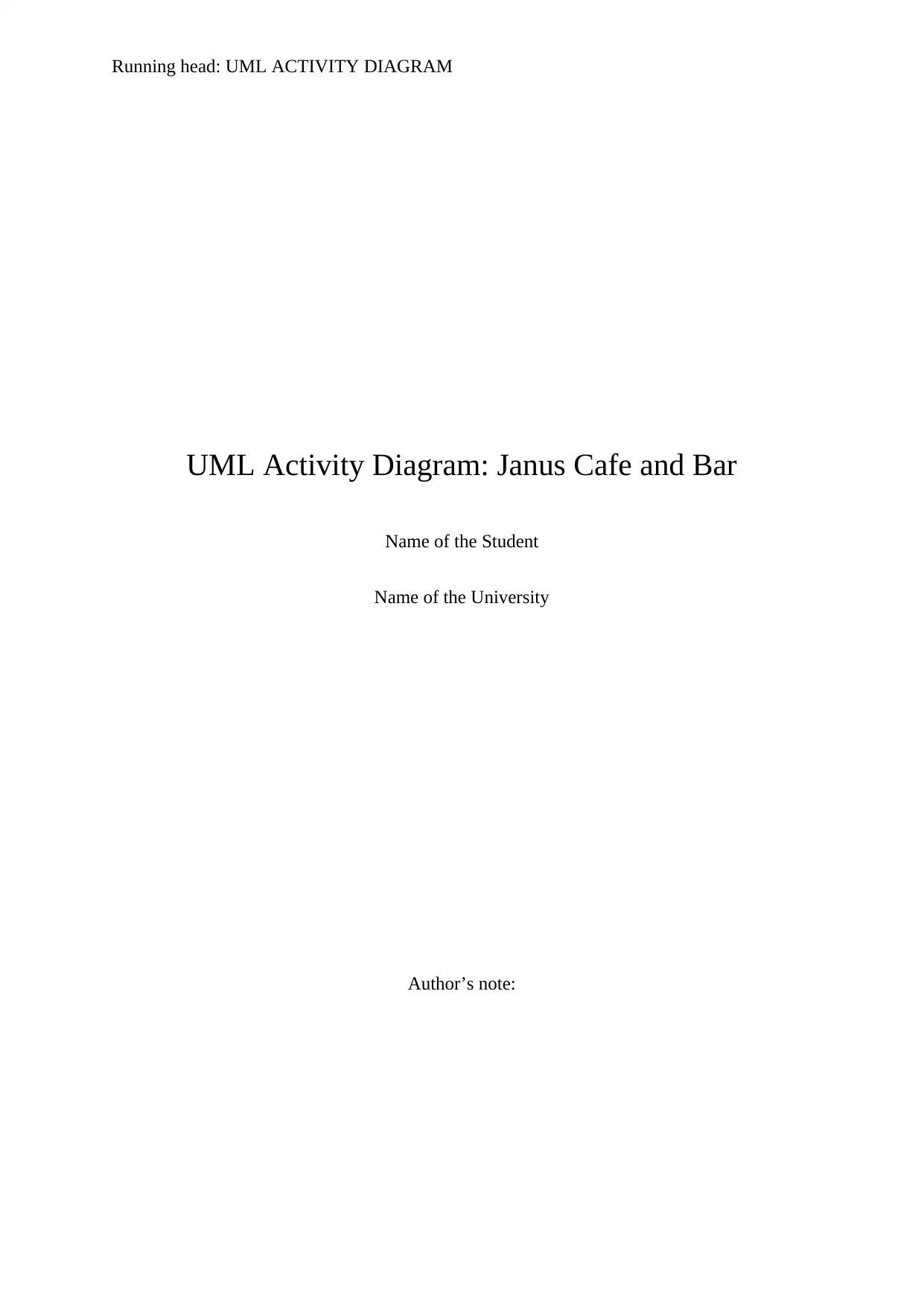
Running head: UML ACTIVITY DIAGRAM
UML Activity Diagram: Janus Cafe and Bar
Name of the Student
Name of the University
Author’s note:
UML Activity Diagram: Janus Cafe and Bar
Name of the Student
Name of the University
Author’s note:
Paraphrase This Document
Need a fresh take? Get an instant paraphrase of this document with our AI Paraphraser
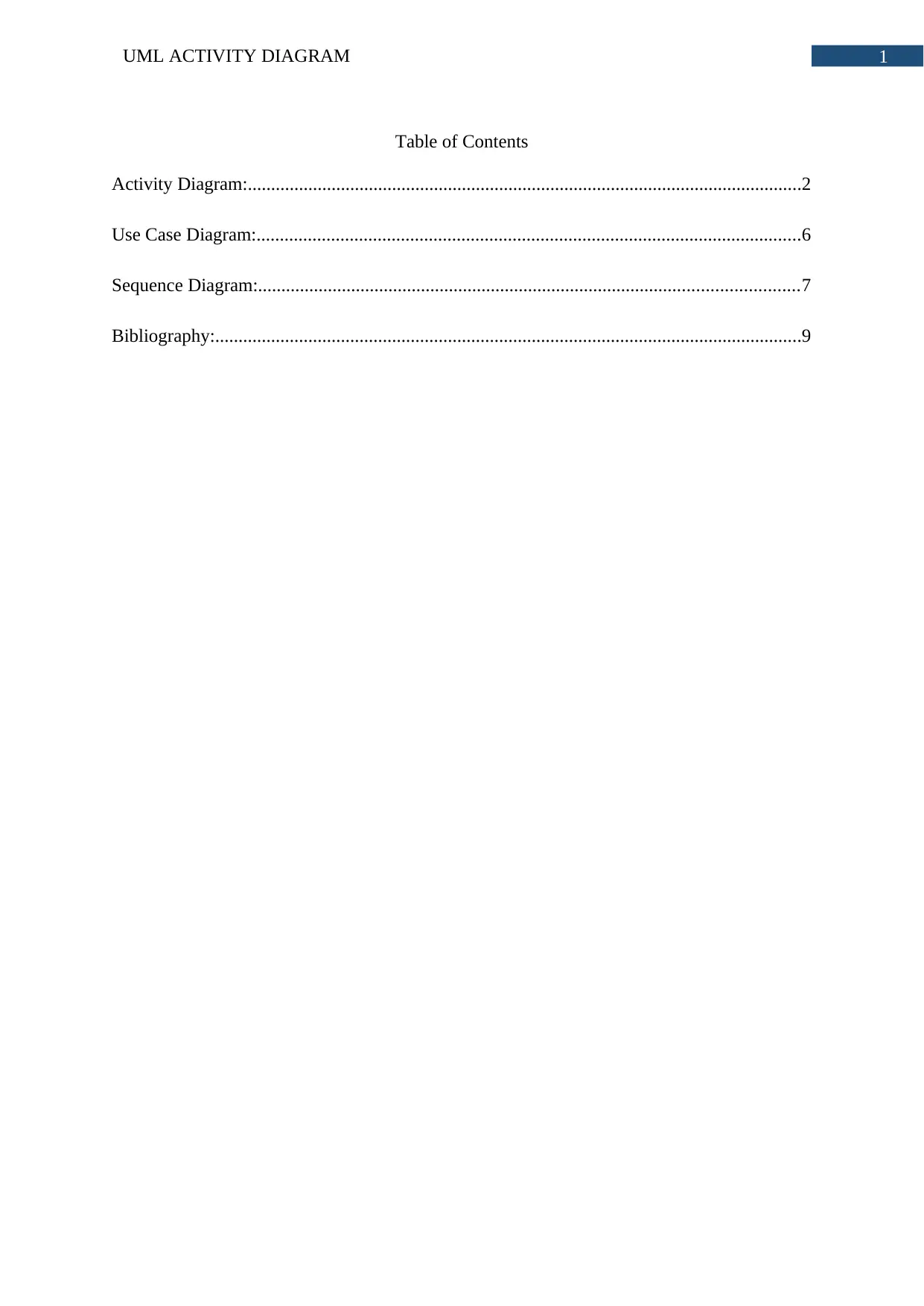
1UML ACTIVITY DIAGRAM
Table of Contents
Activity Diagram:.......................................................................................................................2
Use Case Diagram:.....................................................................................................................6
Sequence Diagram:....................................................................................................................7
Bibliography:..............................................................................................................................9
Table of Contents
Activity Diagram:.......................................................................................................................2
Use Case Diagram:.....................................................................................................................6
Sequence Diagram:....................................................................................................................7
Bibliography:..............................................................................................................................9
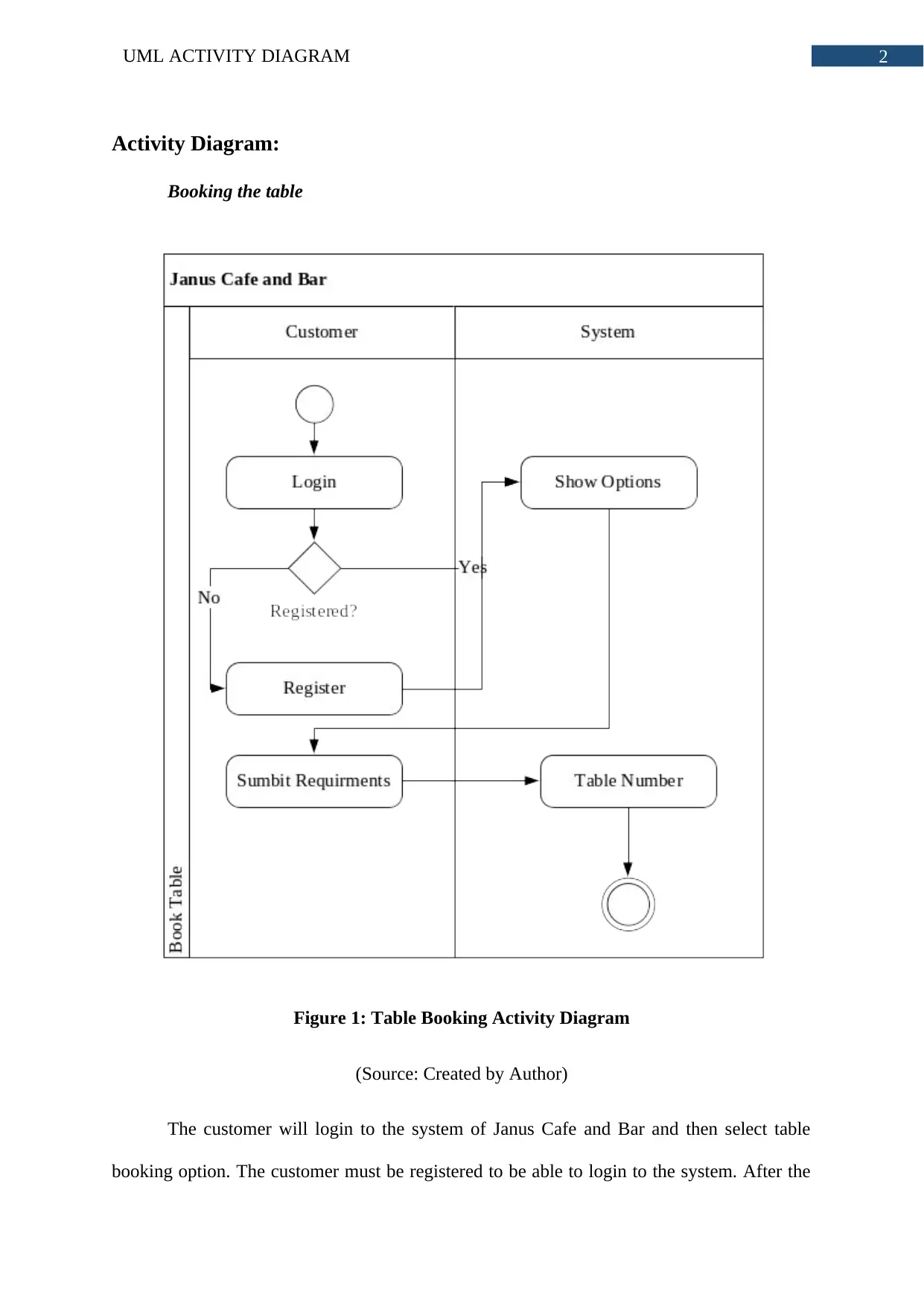
2UML ACTIVITY DIAGRAM
Activity Diagram:
Booking the table
Figure 1: Table Booking Activity Diagram
(Source: Created by Author)
The customer will login to the system of Janus Cafe and Bar and then select table
booking option. The customer must be registered to be able to login to the system. After the
Activity Diagram:
Booking the table
Figure 1: Table Booking Activity Diagram
(Source: Created by Author)
The customer will login to the system of Janus Cafe and Bar and then select table
booking option. The customer must be registered to be able to login to the system. After the
⊘ This is a preview!⊘
Do you want full access?
Subscribe today to unlock all pages.

Trusted by 1+ million students worldwide
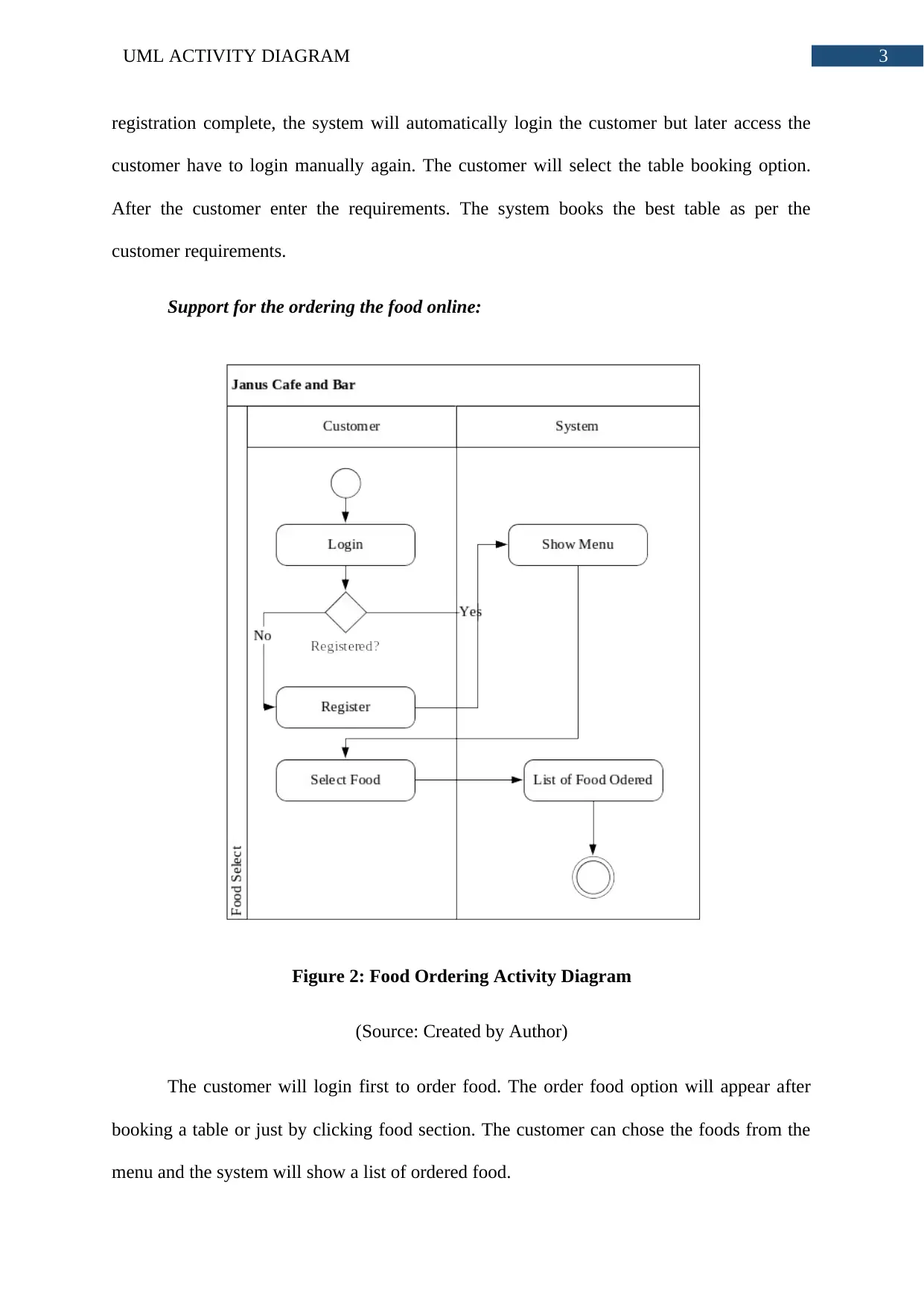
3UML ACTIVITY DIAGRAM
registration complete, the system will automatically login the customer but later access the
customer have to login manually again. The customer will select the table booking option.
After the customer enter the requirements. The system books the best table as per the
customer requirements.
Support for the ordering the food online:
Figure 2: Food Ordering Activity Diagram
(Source: Created by Author)
The customer will login first to order food. The order food option will appear after
booking a table or just by clicking food section. The customer can chose the foods from the
menu and the system will show a list of ordered food.
registration complete, the system will automatically login the customer but later access the
customer have to login manually again. The customer will select the table booking option.
After the customer enter the requirements. The system books the best table as per the
customer requirements.
Support for the ordering the food online:
Figure 2: Food Ordering Activity Diagram
(Source: Created by Author)
The customer will login first to order food. The order food option will appear after
booking a table or just by clicking food section. The customer can chose the foods from the
menu and the system will show a list of ordered food.
Paraphrase This Document
Need a fresh take? Get an instant paraphrase of this document with our AI Paraphraser
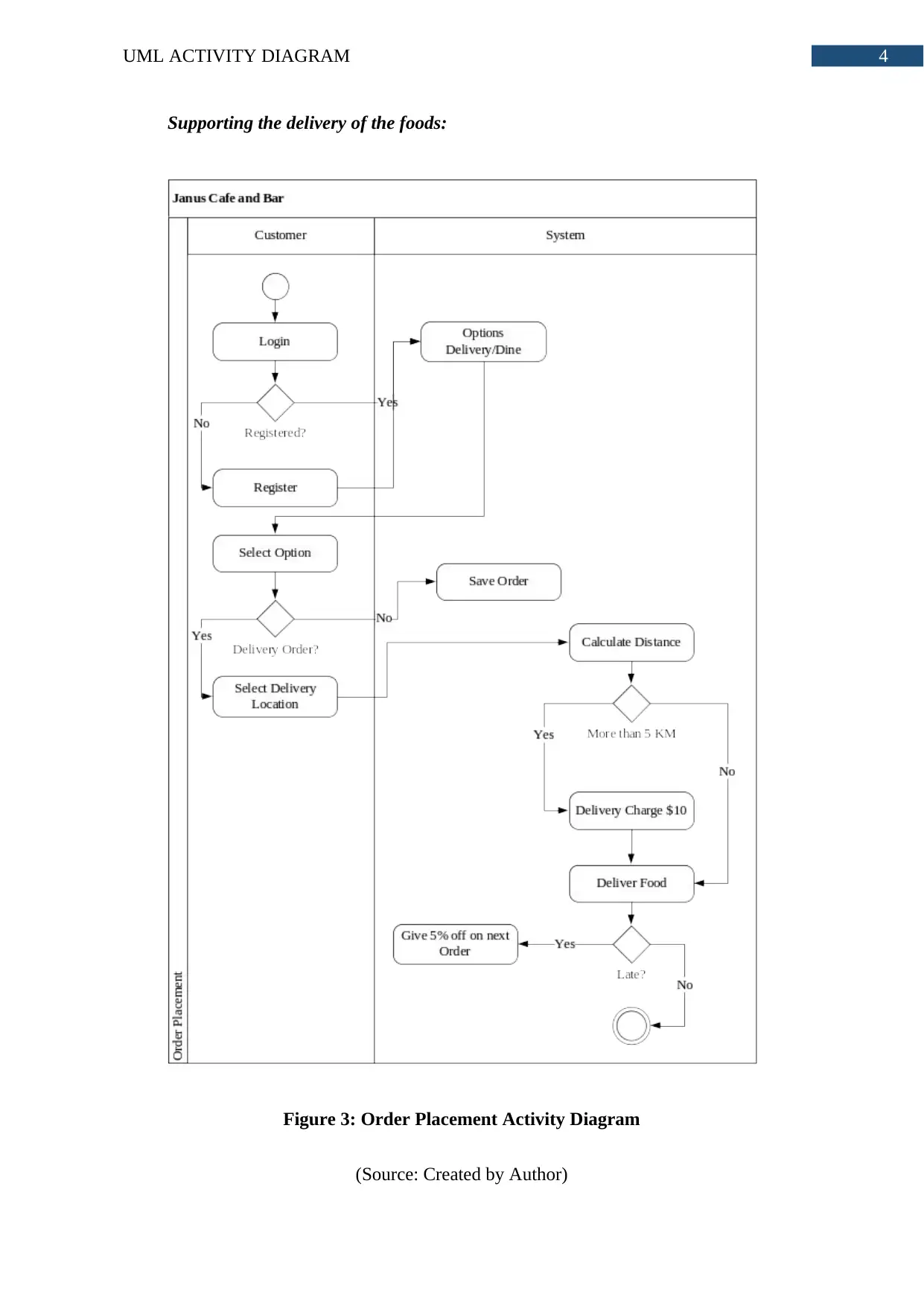
4UML ACTIVITY DIAGRAM
Supporting the delivery of the foods:
Figure 3: Order Placement Activity Diagram
(Source: Created by Author)
Supporting the delivery of the foods:
Figure 3: Order Placement Activity Diagram
(Source: Created by Author)
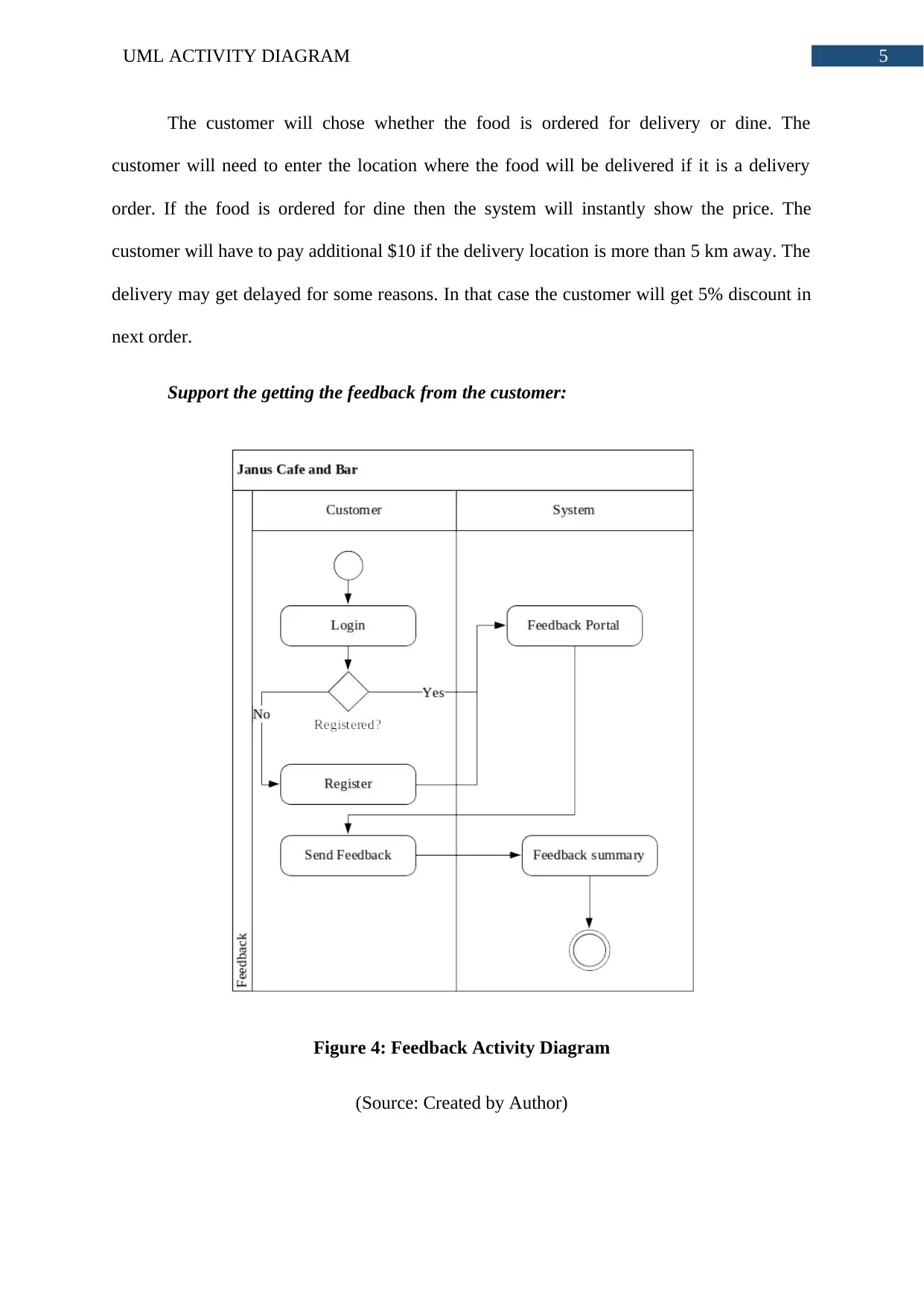
5UML ACTIVITY DIAGRAM
The customer will chose whether the food is ordered for delivery or dine. The
customer will need to enter the location where the food will be delivered if it is a delivery
order. If the food is ordered for dine then the system will instantly show the price. The
customer will have to pay additional $10 if the delivery location is more than 5 km away. The
delivery may get delayed for some reasons. In that case the customer will get 5% discount in
next order.
Support the getting the feedback from the customer:
Figure 4: Feedback Activity Diagram
(Source: Created by Author)
The customer will chose whether the food is ordered for delivery or dine. The
customer will need to enter the location where the food will be delivered if it is a delivery
order. If the food is ordered for dine then the system will instantly show the price. The
customer will have to pay additional $10 if the delivery location is more than 5 km away. The
delivery may get delayed for some reasons. In that case the customer will get 5% discount in
next order.
Support the getting the feedback from the customer:
Figure 4: Feedback Activity Diagram
(Source: Created by Author)
⊘ This is a preview!⊘
Do you want full access?
Subscribe today to unlock all pages.

Trusted by 1+ million students worldwide
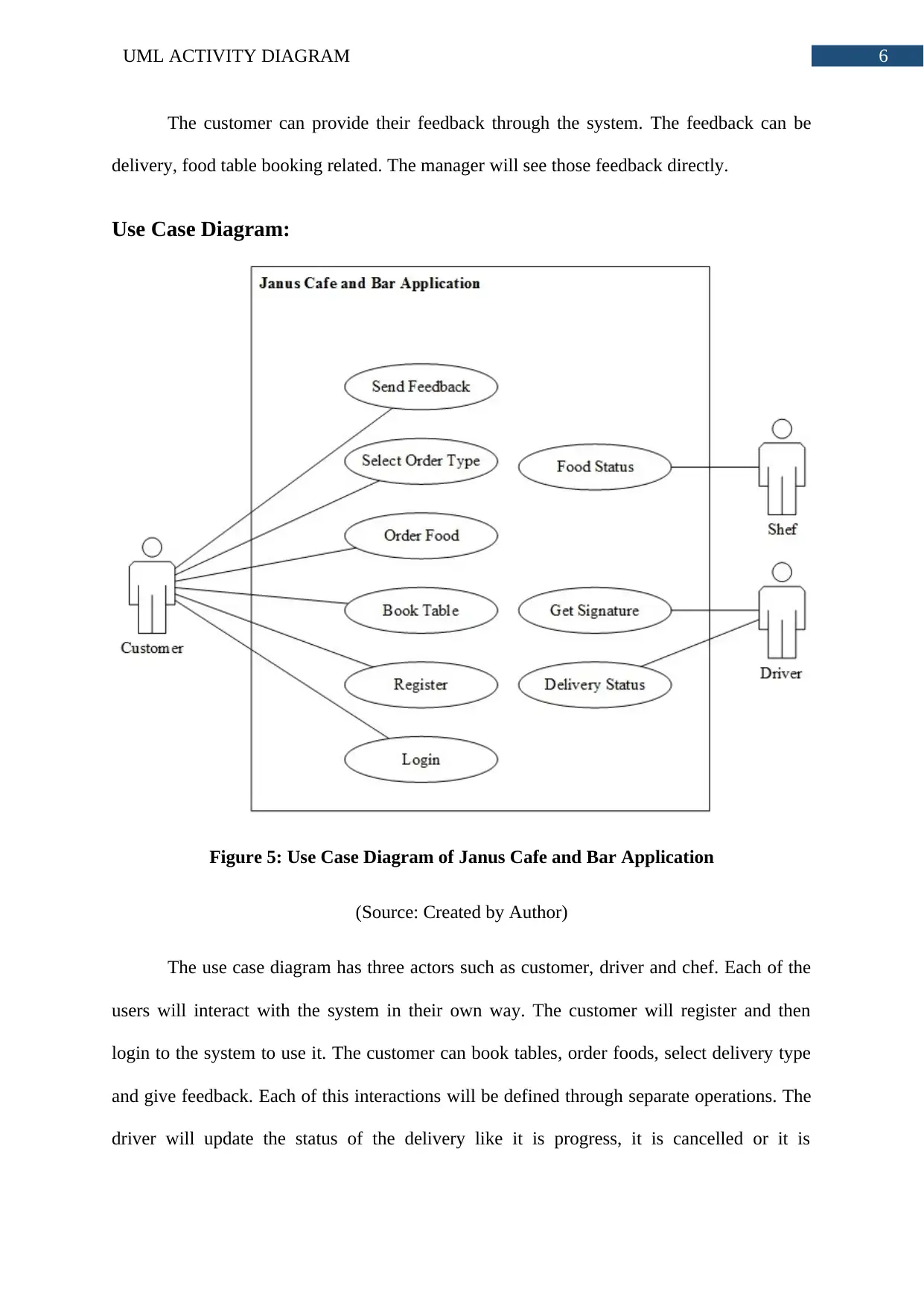
6UML ACTIVITY DIAGRAM
The customer can provide their feedback through the system. The feedback can be
delivery, food table booking related. The manager will see those feedback directly.
Use Case Diagram:
Figure 5: Use Case Diagram of Janus Cafe and Bar Application
(Source: Created by Author)
The use case diagram has three actors such as customer, driver and chef. Each of the
users will interact with the system in their own way. The customer will register and then
login to the system to use it. The customer can book tables, order foods, select delivery type
and give feedback. Each of this interactions will be defined through separate operations. The
driver will update the status of the delivery like it is progress, it is cancelled or it is
The customer can provide their feedback through the system. The feedback can be
delivery, food table booking related. The manager will see those feedback directly.
Use Case Diagram:
Figure 5: Use Case Diagram of Janus Cafe and Bar Application
(Source: Created by Author)
The use case diagram has three actors such as customer, driver and chef. Each of the
users will interact with the system in their own way. The customer will register and then
login to the system to use it. The customer can book tables, order foods, select delivery type
and give feedback. Each of this interactions will be defined through separate operations. The
driver will update the status of the delivery like it is progress, it is cancelled or it is
Paraphrase This Document
Need a fresh take? Get an instant paraphrase of this document with our AI Paraphraser
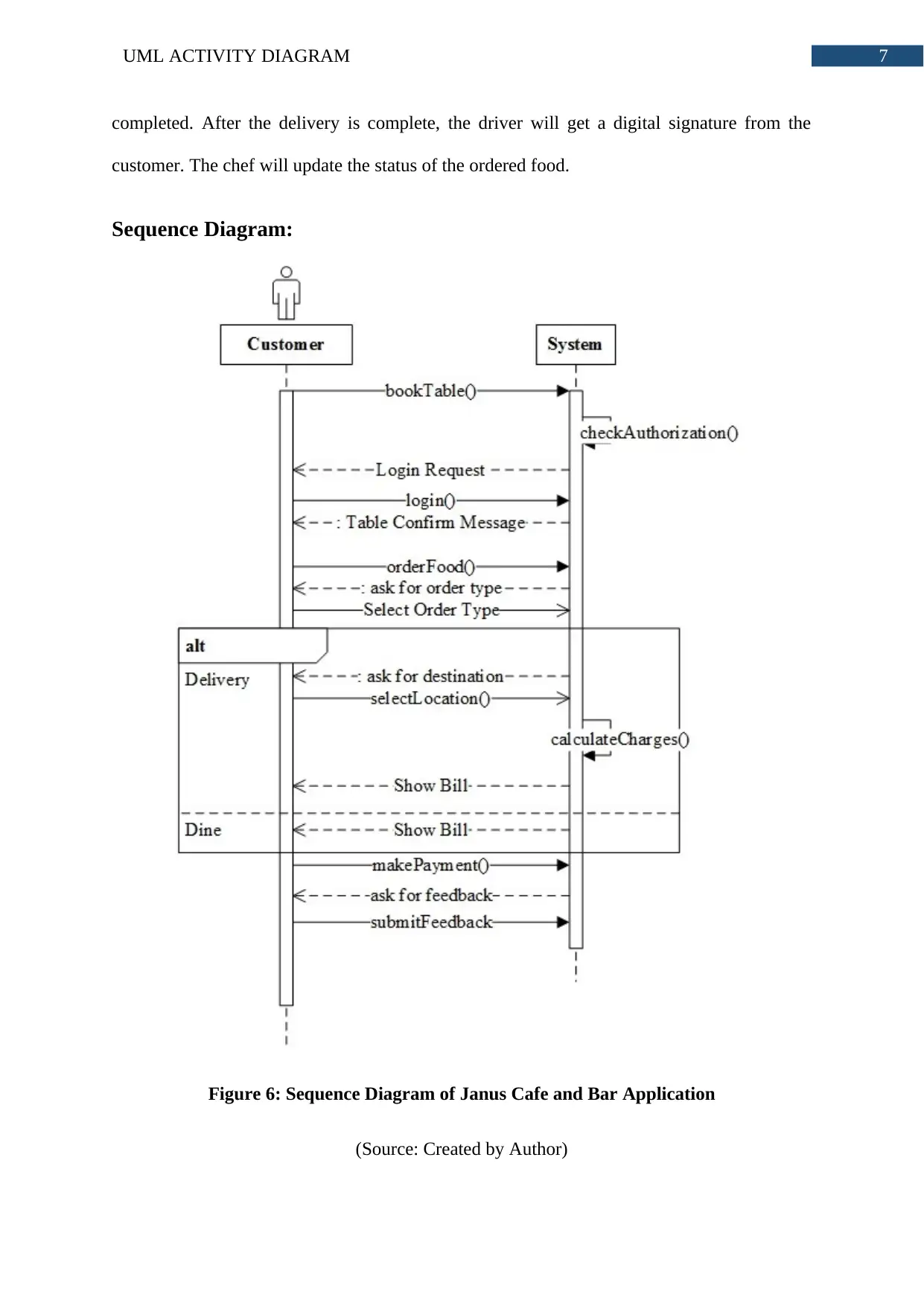
7UML ACTIVITY DIAGRAM
completed. After the delivery is complete, the driver will get a digital signature from the
customer. The chef will update the status of the ordered food.
Sequence Diagram:
Figure 6: Sequence Diagram of Janus Cafe and Bar Application
(Source: Created by Author)
completed. After the delivery is complete, the driver will get a digital signature from the
customer. The chef will update the status of the ordered food.
Sequence Diagram:
Figure 6: Sequence Diagram of Janus Cafe and Bar Application
(Source: Created by Author)
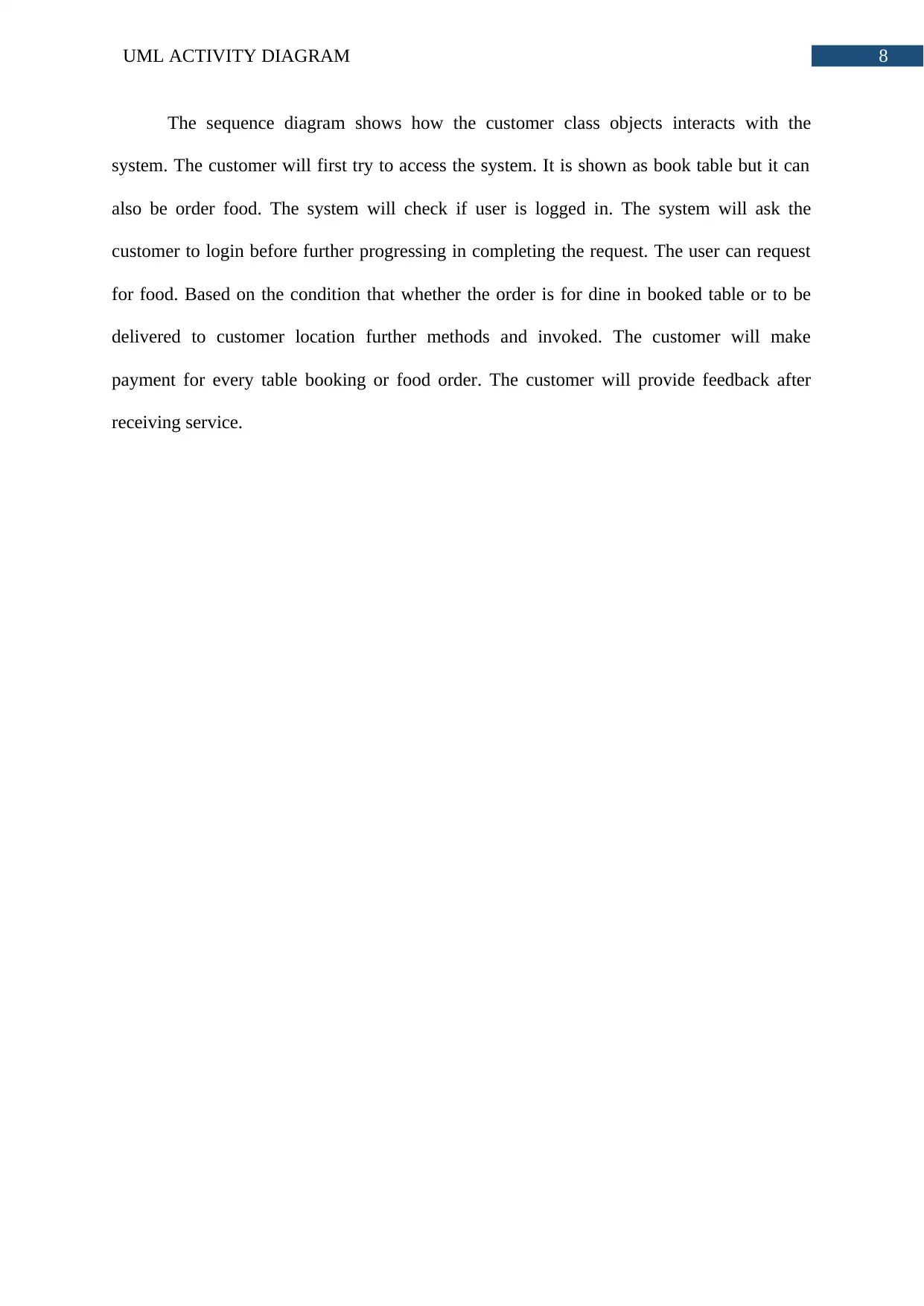
8UML ACTIVITY DIAGRAM
The sequence diagram shows how the customer class objects interacts with the
system. The customer will first try to access the system. It is shown as book table but it can
also be order food. The system will check if user is logged in. The system will ask the
customer to login before further progressing in completing the request. The user can request
for food. Based on the condition that whether the order is for dine in booked table or to be
delivered to customer location further methods and invoked. The customer will make
payment for every table booking or food order. The customer will provide feedback after
receiving service.
The sequence diagram shows how the customer class objects interacts with the
system. The customer will first try to access the system. It is shown as book table but it can
also be order food. The system will check if user is logged in. The system will ask the
customer to login before further progressing in completing the request. The user can request
for food. Based on the condition that whether the order is for dine in booked table or to be
delivered to customer location further methods and invoked. The customer will make
payment for every table booking or food order. The customer will provide feedback after
receiving service.
⊘ This is a preview!⊘
Do you want full access?
Subscribe today to unlock all pages.

Trusted by 1+ million students worldwide
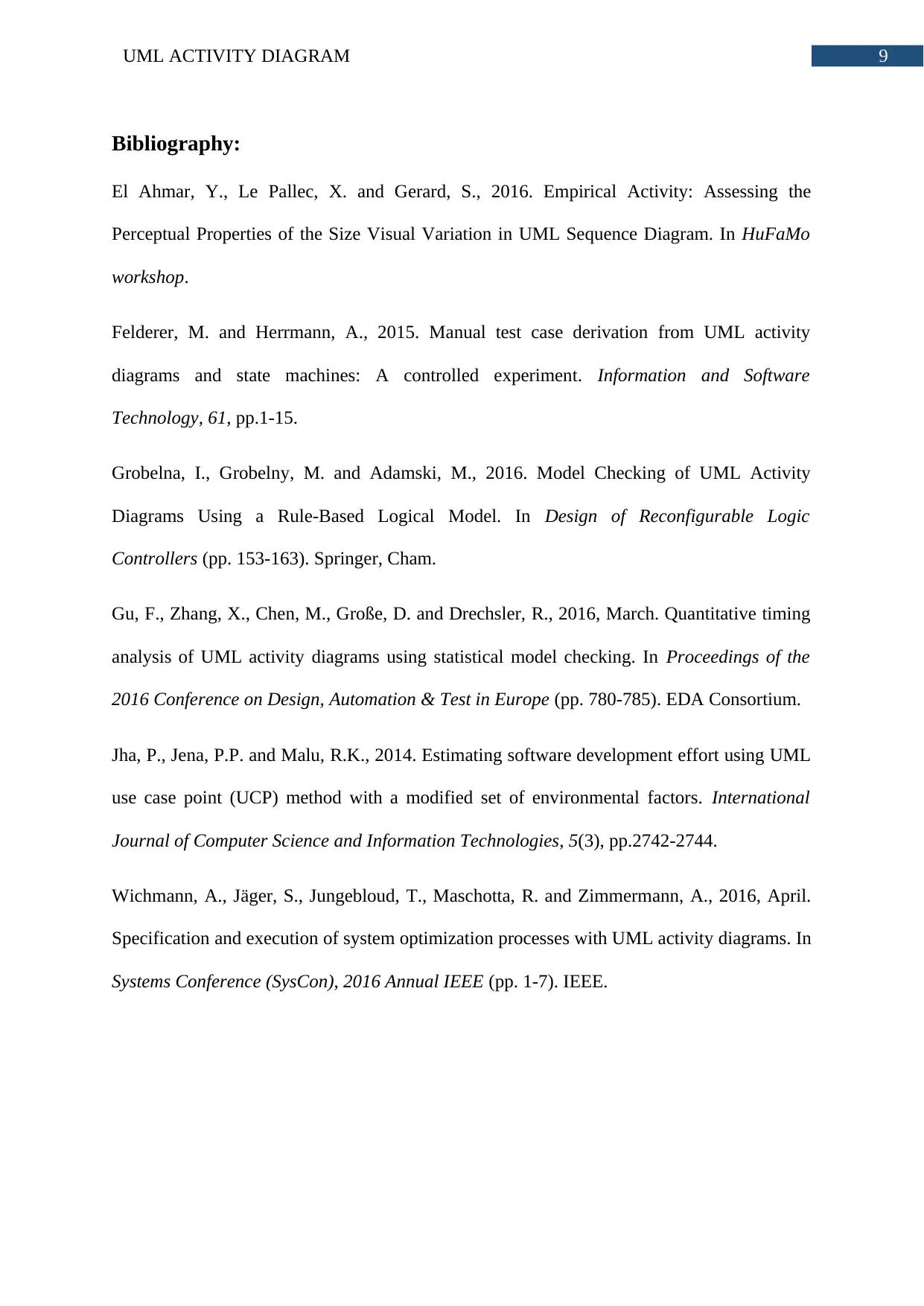
9UML ACTIVITY DIAGRAM
Bibliography:
El Ahmar, Y., Le Pallec, X. and Gerard, S., 2016. Empirical Activity: Assessing the
Perceptual Properties of the Size Visual Variation in UML Sequence Diagram. In HuFaMo
workshop.
Felderer, M. and Herrmann, A., 2015. Manual test case derivation from UML activity
diagrams and state machines: A controlled experiment. Information and Software
Technology, 61, pp.1-15.
Grobelna, I., Grobelny, M. and Adamski, M., 2016. Model Checking of UML Activity
Diagrams Using a Rule-Based Logical Model. In Design of Reconfigurable Logic
Controllers (pp. 153-163). Springer, Cham.
Gu, F., Zhang, X., Chen, M., Große, D. and Drechsler, R., 2016, March. Quantitative timing
analysis of UML activity diagrams using statistical model checking. In Proceedings of the
2016 Conference on Design, Automation & Test in Europe (pp. 780-785). EDA Consortium.
Jha, P., Jena, P.P. and Malu, R.K., 2014. Estimating software development effort using UML
use case point (UCP) method with a modified set of environmental factors. International
Journal of Computer Science and Information Technologies, 5(3), pp.2742-2744.
Wichmann, A., Jäger, S., Jungebloud, T., Maschotta, R. and Zimmermann, A., 2016, April.
Specification and execution of system optimization processes with UML activity diagrams. In
Systems Conference (SysCon), 2016 Annual IEEE (pp. 1-7). IEEE.
Bibliography:
El Ahmar, Y., Le Pallec, X. and Gerard, S., 2016. Empirical Activity: Assessing the
Perceptual Properties of the Size Visual Variation in UML Sequence Diagram. In HuFaMo
workshop.
Felderer, M. and Herrmann, A., 2015. Manual test case derivation from UML activity
diagrams and state machines: A controlled experiment. Information and Software
Technology, 61, pp.1-15.
Grobelna, I., Grobelny, M. and Adamski, M., 2016. Model Checking of UML Activity
Diagrams Using a Rule-Based Logical Model. In Design of Reconfigurable Logic
Controllers (pp. 153-163). Springer, Cham.
Gu, F., Zhang, X., Chen, M., Große, D. and Drechsler, R., 2016, March. Quantitative timing
analysis of UML activity diagrams using statistical model checking. In Proceedings of the
2016 Conference on Design, Automation & Test in Europe (pp. 780-785). EDA Consortium.
Jha, P., Jena, P.P. and Malu, R.K., 2014. Estimating software development effort using UML
use case point (UCP) method with a modified set of environmental factors. International
Journal of Computer Science and Information Technologies, 5(3), pp.2742-2744.
Wichmann, A., Jäger, S., Jungebloud, T., Maschotta, R. and Zimmermann, A., 2016, April.
Specification and execution of system optimization processes with UML activity diagrams. In
Systems Conference (SysCon), 2016 Annual IEEE (pp. 1-7). IEEE.
1 out of 10
Related Documents
Your All-in-One AI-Powered Toolkit for Academic Success.
+13062052269
info@desklib.com
Available 24*7 on WhatsApp / Email
![[object Object]](/_next/static/media/star-bottom.7253800d.svg)
Unlock your academic potential
Copyright © 2020–2025 A2Z Services. All Rights Reserved. Developed and managed by ZUCOL.





